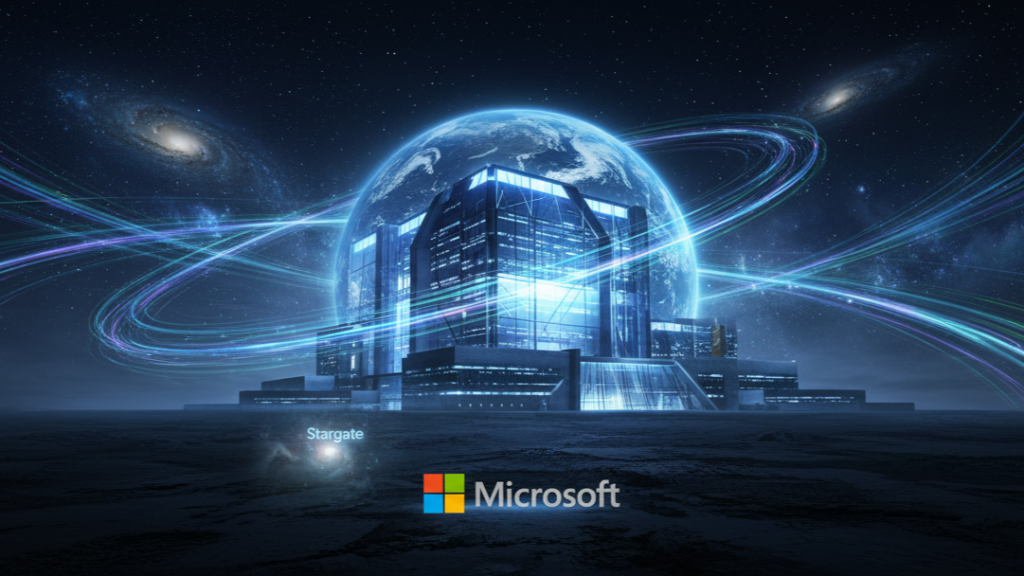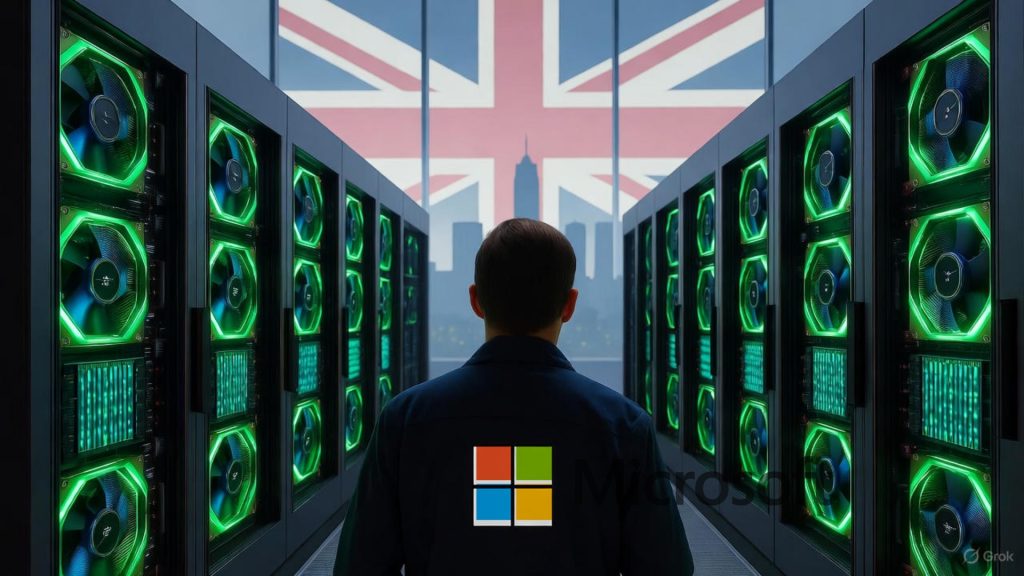
The landscape of artificial intelligence is defined by a furious, trillion-dollar race for compute power. At the heart of this competition are two titans, historically partners, now carving out distinct infrastructure strategies: Microsoft and OpenAI. In a significant strategic pivot that signals a deepening competitive dynamic, Microsoft is charting its own course, opting to bypass involvement in OpenAI’s ambitious $500 billion ‘Stargate’ project to focus on a massive, independently-funded global buildout.
This decision underscores Microsoft’s commitment to self-reliance and its vision of becoming the undisputed AI infrastructure backbone for the entire global enterprise.
Read Also: Switch to Zoho Mail Free: Amit Shah's Bold Move
Microsoft’s commitment to this independent path is backed by staggering numbers. The company’s capital expenditure (CapEx) is projected to soar to $120 billion in FY26, a huge increase dedicated primarily to funding next-generation data centers and a massive global AI network. This investment is not just about scale; it’s about control, speed, and securing a long-term competitive advantage in the AI race Microsoft vs OpenAI.
Here are the key takeaways from Microsoft’s new AI strategy FY26:
- Bypassing Stargate: Microsoft is opting out of a direct role in OpenAI’s $500 billion ‘Stargate’ initiative, signaling a strategic decoupling in infrastructure development.
- Record CapEx: Microsoft’s projected $120B capex for Fiscal Year 2026 will be hyper-focused on AI data centers investment and networking.
- Strategic Global Buildout: The funds are earmarked for a global AI data infrastructure network, including a major Microsoft UK AI investment to secure regional compute hubs.
The $120 Billion Bet: Redefining Microsoft AI Infrastructure
The projected $120 billion in capital expenditure for FY26 represents one of the most aggressive infrastructure spending programs in tech history. This investment is an explicit statement: Microsoft is determined to own the end-to-end stack—from the silicon (like its custom Maia AI accelerators and massive purchases of NVIDIA GPUs) to the hyperscale data centers that house them.
This financial commitment dwarfs previous spending cycles and is designed to create an unparalleled global AI data infrastructure. The focus is on building “AI factories”—gigawatt-scale compute clusters designed specifically to train and run the world’s most advanced generative AI models, including those from OpenAI, Anthropic, and potentially dozens of other model developers.
The company’s strategy leans heavily on its existing Azure cloud platform, leveraging its massive geographic footprint of over 300 data centers in 34 countries. By accelerating the expansion of these facilities and outfitting them with elite hardware, Microsoft is solidifying its position as the premier hyperscaler AI race contestant. This move ensures that enterprise customers adopting Microsoft cloud AI strategy don’t face capacity constraints, a growing pain point across the industry.
The Dynamics of AI Capex Trends
The magnitude of Microsoft’s spending, which includes multi-billion dollar deals with infrastructure partners like Nebius Group for GPU capacity, highlights the intense financial pressure of the compute infrastructure arms race.
For comparison, as recently as the fourth quarter of FY25, Microsoft’s CapEx was around $24.2 billion, with a projected $30 billion in the next quarter. The jump to a forecasted $120 billion for the full fiscal year 2026 illustrates an exponential acceleration of the company’s commitment to AI. Competitors like Meta and Google are also intensifying their CapEx, but Microsoft’s projected outlay by FY26 sets a new high-water mark, showcasing a clear and urgent intent to dominate AI infrastructure spending.
Strategic Departure: Why Microsoft Skipped OpenAI Stargate
OpenAI’s ‘Stargate’ is a multi-phase, $500 billion initiative aimed at building one of the world’s largest-ever AI supercomputing networks, requiring an estimated 10 gigawatts of power. While Microsoft remains a crucial partner to OpenAI—providing the Azure environment for model training and deployment via Azure OpenAI—the decision to skip the Stargate joint venture is a pragmatic move rooted in long-term strategic independence.
The relationship between the two companies has evolved from a foundational partnership to a complex “co-opetition.” Microsoft benefits immensely from access to OpenAI’s models, while OpenAI relies on Microsoft’s Azure cloud. However, OpenAI has increasingly sought its own infrastructure independence, securing funding from SoftBank, Oracle, and others for Stargate.
Microsoft’s Stargate alternative is simple: why co-fund a separate entity when you can own and control the entire capacity within your own highly successful, globally distributed Azure ecosystem?
- Control and Exclusivity: By building its own network, Microsoft retains full control over hardware selection, design, deployment, and, critically, capacity allocation. This is essential for delivering the guaranteed service levels required by its large enterprise customers.
- Multi-Model Strategy: The new infrastructure is designed to support not only OpenAI’s models but also those from rivals like Anthropic (which Microsoft is also integrating into products like Office 365) and Meta’s Llama. This multi-model, enterprise AI strategy future-proofs Microsoft against potential shifts in the AI model landscape.
- Geopolitical Resilience: A fully owned Microsoft global AI network allows the company to rapidly deploy compute power in regions critical for national or geopolitical reasons, a key aspect of next-gen AI infrastructure. The massive investment in the UK is a prime example of this strategy.
The UK: A Crucial Hub for Microsoft UK AI Investment

A substantial portion of the record CapEx is directed towards major Microsoft UK AI investment. The UK has been explicitly named as a key beneficiary of this global infrastructure push, with a commitment that includes building the country’s largest-ever supercomputer, featuring over 23,000 NVIDIA GPUs, in partnership with Nscale.
This investment is calculated to serve two main purposes:
- Meet Surging Demand: It addresses the soaring demand for advanced AI compute from major UK customers across finance (like the London Stock Exchange Group), healthcare (the NHS), and enterprise (Unilever, Barclays).
- Strategic Alignment: It reinforces the UK-US technology partnership, securing the UK’s position as a global leader in generative AI growth and aligning with government-led initiatives to bolster national tech capabilities.
This UK tech investments by Microsoft commitment is a microcosm of the broader global strategy: placing high-performance AI compute closer to the points of data generation and consumption to minimize latency and ensure data governance compliance for regional clients.
FAQs on Microsoft’s AI Infrastructure Shift
❓ What is the OpenAI Stargate Project?
The OpenAI Stargate Project is a massive, multi-phase initiative by OpenAI, SoftBank, Oracle, and others to invest up to $500 billion over several years in building a new, enormous network of AI supercomputing data centers, primarily in the United States, designed for next-generation model training.
❓ Why is Microsoft increasing its CapEx to $120 Billion in FY26?
Microsoft is increasing its capital expenditure 2026 to $120 billion to independently build out its own global Microsoft AI infrastructure network of hyperscale data centers. This is driven by surging customer demand for AI compute through its Azure cloud platform and a strategic need to control its own destiny in the AI data centers investment race.
❓ How does Microsoft’s new strategy affect its partnership with OpenAI?
While Microsoft is not directly participating in the Stargate venture, the operational partnership remains robust. Microsoft Azure is still the primary cloud platform for OpenAI’s existing model training and commercial deployment via Azure OpenAI Service. However, this move signals that Microsoft is strategically reducing its infrastructure reliance on a single partner by building an independent, multi-model infrastructure to support all frontier AI developers.
❓ Which specific area is the focus of Microsoft’s investment in the UK?
Microsoft’s significant Microsoft AI investments in the UK include $15 billion in capital expenditures for cloud and AI infrastructure buildouts from 2025 to 2028. A key part of this plan is the creation of the country’s largest supercomputer, featuring over 23,000 NVIDIA GPUs, to support local industry and scientific research.
This bold, multi-billion dollar move marks a new chapter in the AI compute war. Microsoft is transforming itself from merely a cloud provider that hosts AI models into the essential, independent engine of global AI progress. By committing to an extraordinary $120B capex, the company isn’t just reacting to demand; it’s aggressively dictating the pace and scale of the AI data infrastructure market. This strategy is a testament to the belief that in the age of generative AI, owning the metal is the ultimate form of strategic leverage.
As Microsoft races to deploy these AI-driven data center expansion plans, the question remains: Can any competitor match this level of sustained, self-funded infrastructure investment?
Source Article Credit: Based on information compiled from multiple authoritative sources including the original topic headline, with additional context from OpenAI on the Stargate Project and Microsoft’s official UK investment announcements
This video discusses the context of the intense competition in the tech world regarding AI infrastructure, which is highly relevant to Microsoft’s decision to independently invest heavily in its own data centers instead of joining the Stargate project.